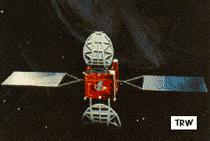Odyssey
 The Odyssey satellite network will provide global voice, fax, and message communications services to users equipped with portable handsets. The system is being developed as a joint commercial venture (called Odyssey Worldwide Services) by TRW and Teleglobe Canada. Operations are planned to begin by the end of 1998. TRW estimates that it will cost $1.8B to build and launch the 12 satellites (with two ground spares), install ground stations in the US, and operate the system for 1 year. User costs are expected to be $250 - $300 for the cellular phone handset, $24 monthly charge, and 65 cents/minute use charges and 10 cents/minute access fees. TRW received FCC license in early 1995. Initial operation (end of 1998) will be provided by 6 satellites giving limited service to selected regions. The full
constellation of 12 satellites is planned to be in place by the end of 1999.
The Odyssey satellite network will provide global voice, fax, and message communications services to users equipped with portable handsets. The system is being developed as a joint commercial venture (called Odyssey Worldwide Services) by TRW and Teleglobe Canada. Operations are planned to begin by the end of 1998. TRW estimates that it will cost $1.8B to build and launch the 12 satellites (with two ground spares), install ground stations in the US, and operate the system for 1 year. User costs are expected to be $250 - $300 for the cellular phone handset, $24 monthly charge, and 65 cents/minute use charges and 10 cents/minute access fees. TRW received FCC license in early 1995. Initial operation (end of 1998) will be provided by 6 satellites giving limited service to selected regions. The full
constellation of 12 satellites is planned to be in place by the end of 1999.
Spacecraft
Spacecraft will rotate attitude to remain focused on a service region. Solar power is
4600 W (EOL). The satellites will connect the user to a Ka-band ground station, where the call is routed into the normal telephone system. No satellite crosslinks are used in this constellation. Each region will have one ground station equipped with four 16.4 ft antennas. 10 - 11 stations are planned worldwide.
Payload
Channel capacity of each satellite: 3000 digital voice circuits at 4.8 kbps. Total beamwidth: 40 deg. provides coverage to regions 7400 km across. The beam is made
up of 37 cells, each covering a 1100 km diameter circle. Power distribution will allow up to 25% of total satellite power to be concentrated in one cell, and 75% of the
capacity could be focused on 10% of a region. Link margin is 6 to 10 dB. Each satellite has 37x25W bent-pipe S-Band transmitters (2486.42, 2491.75 and 2497.06 Mhz) with antenna gain of 25-30 dB from a 5.2 ft reflector. Handset transmitter power will be 0.5W with a hemispherical antenna pattern using L-Band uplink (1612.32, 1618.25 and 1623.58 Mhz). Each of the 6 channels (3 uplink and 3 downlink) are 5.5 Mhz wide. The L-Band signals are received by the S/C with an 8 ft reflector. Signals will use spread-spectrum CDMA.
| Country of Origin | United States |
| Customer/User | Odyssey Worldwide Services (commercial venture) |
| Manufacturer(s) | TRW, Teleglobe |
| Launch | First launch planned for third quarter of 1998. To be launched 2 at a time on Atlas IIAS |
| Orbit | MEO, 10350 km circular, 50 deg inclination, 4 S/C evenly spaced in each of three planes. Orbit period is 6 hours. |
| Design Life | 15 years |
| Related Sites | TRW Odyssey Info |
Information in The Mission and Spacecraft Library is provided without warranty or guarantee. USE AT YOUR OWN RISK.